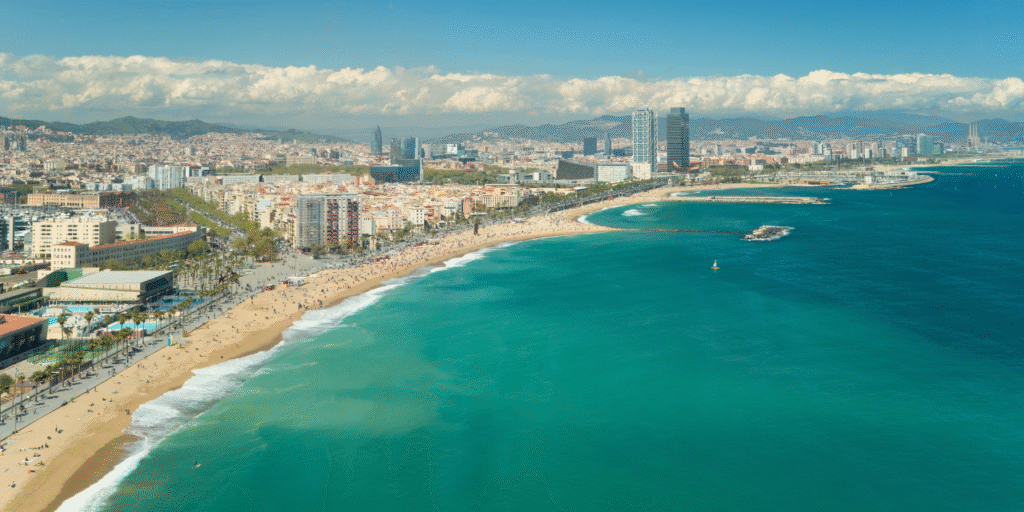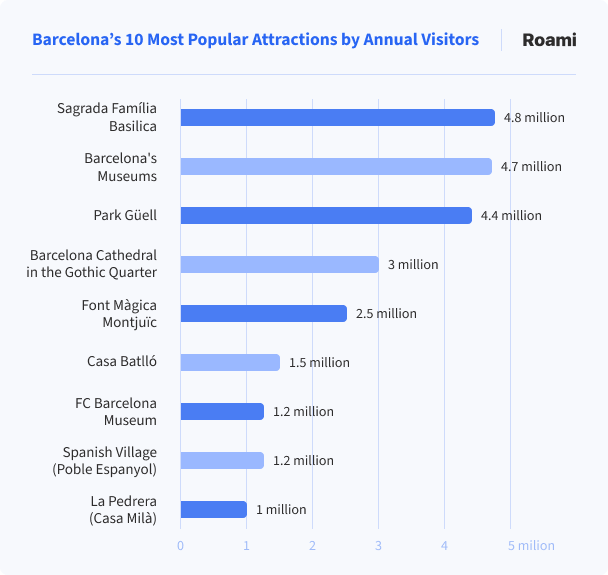Looking for the perfect stay in Edinburgh? Whether you're after luxury, unique design, or cozy comfo...
Travel Guides
Barcelona greets you with color, rhythm, and flavors you’ll think about long after you leave. The only thing harder than packing your days here is packing your bags to go.


Barcelona welcomes around 14 million overnight visitors a year, making it one of Europe’s top five most visited cities. The average stay is about 5 nights, giving travelers time to explore beyond the postcard sights. But is that enough or, rather, how many days to spend in Barcelona?
In this article, we’ll look at what draws so many people here year after year, how tourism is shaping the city’s neighborhoods, and practical tips for making the most of your own visit - whether you’ve got two days or a week to spare.
Barcelona, Spain’s second-largest city and the capital of Catalonia, blends over 2,000 years of history with a modern, Mediterranean lifestyle. Its energy comes from the mix - ancient streets alive with contemporary design, music, and street life at every turn.
Roman ruins, Gothic cathedrals, and Gaudí’s UNESCO-listed masterpieces like Sagrada Família and Park Güell share space with 4.5 km of city beaches, more than 50 museums, and festivals that keep the calendar full year-round.
Food lovers can dive into Michelin-starred dining, lively markets like La Boquería, and a thriving tapas culture. From casual vermouth bars to boundary-pushing gastronomy, eating here is as much a cultural experience as sightseeing.
Compact and well-connected by metro, Barcelona is easy to explore one neighborhood at a time, with day trips to Montserrat, Girona, or Sitges adding even more variety. It works just as well for a packed weekend of sightseeing as for a week-long mix of relaxation.
Stay connected from the moment you land. See our 2025 guide to the best eSIM for Spain.
One day in Barcelona requires early starts, but you can absolutely see the city's highlights:
This little route is just 4 km of walking and gives you the best of Barcelona in one day.
Don’t forget the essentials! Spain uses Type C and Type F plugs with 230V power. Check our 2025 guide to Spain plug types before you go.
Three days in Barcelona changes everything. Instead of rushing from one sight to the next, you actually get to taste the city - literally and figuratively:
Source: Condé Nast Traveller
Source: Lonely Planet
A full week in Barcelona means you can slow down, dig deeper, and see sides of the city most tourists miss:
Use the three-day itinerary we covered earlier - but take it easy. Spend whole mornings in one neighborhood instead of rushing around.
If you’re exploring beyond Barcelona, our Spain itinerary can help you plan the perfect route.
Day four is all about Montjuïc Hill. Visit the National Art Museum of Catalonia (MNAC) for its incredible Romanesque art, then the Joan Miró Museum for a burst of color and creativity.
Check out the 1992 Olympic sites and take the cable car for sweeping city views. Pop into Montjuïc Castle for history and more panoramas. In the evening, catch the Magic Fountain show for music, lights, and water theatrics.
On day five, go where few tourists do. Poblenou mixes old factories turned into art spaces with wide beaches like Bogatell and Mar Bella that feel calmer than Barceloneta.
Then wander through Sants, a real local neighborhood. If it’s Sunday, don’t miss Mercat dels Encants, a massive flea market full of antiques, books, and vintage finds.
Pick a day trip that suits your mood:
Or, spend the time diving deeper into the city: wander Horta-Guinardó for the peaceful Parc del Laberint d’Horta (€2.50, daily visitor limit) or climb up to Bunkers del Carmel, the locals’ favorite free viewpoint.
Explore the Sant Pau Art Nouveau Site, a stunning former hospital, and if you can, catch a concert at the Palau de la Música Catalana, where stained glass and mosaics turn the whole room into a work of art.
Within a week, you won’t just see Barcelona - you’ll start to feel like you belong here.

Barcelona’s Mediterranean climate makes it a great destination any time of year - but when you go can make a big difference to your experience, your budget, and how crowded the city feels.
Barcelona is fantastic year-round, but if you want the perfect mix of great weather, manageable crowds, and better prices, aim for spring or fall. During these months, sunny days hover around 20–22°C (68–72°F), rain is rare, and hotels are cheaper.
If you’re visiting in late September, you might catch La Mercè Festival, Barcelona’s biggest party of the year. Expect concerts, colorful parades, and human tower competitions. Just remember, this celebration draws huge crowds, so book your accommodation months in advance.
July often pushes past 30°C (86°F) with humidity, so you’ll want to plan slower afternoons or stick to shady streets. On the plus side, the beaches are at their best and the sun doesn’t set until after 9:30 PM, giving you long days for exploring.
The city slows down and feels more authentic. Fewer tourists, lower prices, and mild weather (around 15°C / 59°F) make it a great time to focus on museums, food, and culture. You might get a few rainy days, but without the crowds, you can really take your time.
You want to avoid late February through early March when Mobile World Congress brings 100,000 tech professionals to Barcelona. Hotel prices triple, restaurants require reservations weeks ahead, and transportation becomes crowded.
Planning beyond the city? The best time to visit Spain varies by region - and our Fun facts about Spain that you probably didn’t know will give you plenty of brilliant reasons to go.
1. Is 1 day enough to see Barcelona?
One day is enough to catch the city’s highlights, but it will feel like a sprint. You’ll get a taste of Barcelona’s beauty, but not the deeper culture, food, and neighborhoods that make it truly special.
2. What can I do in 3 days in Barcelona?
Three days lets you balance must-see sights with time to explore at a relaxed pace. You can cover Gaudí’s landmarks, wander the Gothic and El Born quarters, enjoy the beaches, and even squeeze in a market visit.
3. Is 7 days too long in Barcelona?
Seven days isn’t too long if you’re curious to go beyond the tourist trail. You can explore lesser-known neighborhoods, take day trips to places like Montserrat or Girona, and still have time to relax at the beaches.
4. Can I visit Barcelona on a day trip?
Yes, if you’re already nearby - say in Madrid via high-speed train or stopping on a cruise - it’s possible to see a few highlights in one long day. Just know you’ll be choosing breadth over depth and missing much of what makes the city shine.
5. What is the best month to visit Barcelona?
Late April–May and September–October are ideal, with pleasant temperatures, fewer crowds, and lower hotel rates than summer. You’ll get sunny weather perfect for walking tours and even a dip in the Mediterranean.
6. Should I stay in the city center of Barcelona?
Staying central - around the Gothic Quarter, Eixample, or El Born - puts you within walking distance of major sights and great dining. It may cost a bit more, but the convenience is worth it for most visitors.
7. What's the best way to explore Barcelona?
Mix walking with the city’s excellent metro system so you can cover ground quickly without missing the charm of its streets. Barcelona is also perfect for exploring neighborhood by neighborhood.
8. Are there good day trips from Barcelona?
Absolutely - Montserrat for mountain views and monasteries, Girona for medieval charm, and Sitges for beaches and nightlife are all easy options. Each offers a completely different slice of Catalonia within an hour or so of the city.

